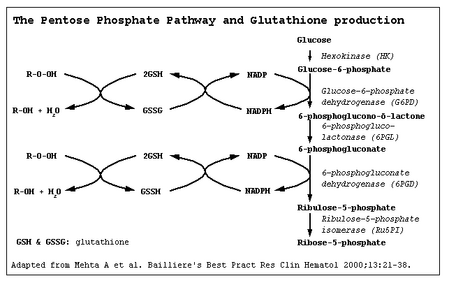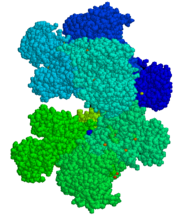Definition
Glucose-6-phosphate dehydrogenase deficiency is an inherited condition caused by a defect or defects in the gene that codes for the enzyme, glucose-6-phosphate dehydrogenase (G6PD). It can cause hemolytic anemia, varying in severity from life-long anemia, to rare bouts of anemia to total unawareness of the condition. The episodes of hemolytic anemia are usually triggered by oxidants, infection, or by eating fava beans.
Description
G6PD deficiency is the most common enzyme deficiency in the world, with about 400 million people living with it. It is most prevalent in people of African, Mediterranean, and Asian ancestry. The incidence in different populations varies from zero in South American Indians to less than 0.1% of Northern Europeans to about 50% of Kurdish males. In the United States, it is most common among African American males; about 11 to 14% are G6PD-deficient.
G6PD deficiency is a recessive sex-linked trait. Thus, males have only one copy of the G6PD gene, but females have two copies. Recessive genes are masked in the presence of a gene that encodes normal G6PD. Accordingly, females with one copy of the gene for G6PD deficiency are usually normal, while males with one copy have the trait.
G6PD is present in all human cells but is particularly important to red blood cells. It is required to make NADPH in red blood cells but not in other cells. It is also required to make glutathione. Glutathione and NADPH both help protect red blood cells against oxidative damage. Thus, when G6PD is defective, oxidative damage to red blood cells readily occurs, and they break open as a result. This event is called hemolysis, and multiple hemolyses in a short time span constitute an episode of hemolytic anemia.
As of 1998, there are almost 100 different known forms of G6PD enzyme molecules encoded by defective G6PD genes, yet not one of them is completely inactive. This suggests that G6PD is indispensable. Many G6PD defective enzymes are deficient in their stability rather than their initial ability to function. Since red blood cells lack nuclei, they, unlike other cells, cannot synthesize new enzyme molecules to replace defective ones. Hence, we expect young red blood cells to have new, functional G6PD and older cells to have non-functioning G6PD. This explains why episodes of hemolytic anemia are frequently self-limiting; new red blood cells are generated with enzymes able to afford protection from oxidation.
The geographic distribution of G6PD deficiency, allowing for migration, coincides with the geographic distribution of malaria. This fact and survival statistics suggest that G6PD deficiency protects against malaria.
Glucose-6-phosphate dehydrogenase deficiency is also known as G6PD deficiency, favism, and primaquine sensitivity.
Causes & symptoms
Causes
G6PD deficiency is caused by one copy of a defective G6PD gene in males or two copies of a defective G6PD gene in females. Hemolytic anemic attacks can be caused by oxidants, infection, and or by eating fava beans.
Symptoms
The most significant consequence of this disorder is hemolytic anemia, which is usually episodic, but the vast majority of people with G6PD deficiency have no symptoms.
The many different forms of G6PD deficiency have been divided into five classes according to severity.
The major symptoms of hemolytic anemia are jaundice, dark urine, abdominal pain, back pain, lowered red blood cell count, and elevated bilirubin. People who suffer from severe and chronic forms of G6PD deficiency in addition may have gallstones, enlarged spleens, defective white blood cells, and cataracts.
- Class 1--enzyme deficiency with chronic hemolytic anemia
- Class 2--severe enzyme deficiency with less than 10% of normal activity
- Class 3--moderate to mild enzyme deficiency with 10-60% of normal activity
- Class 4--very mild or no enzyme deficiency
- Class 5--increased enzyme activity Fortunately, only a small number of people fall into Class 1.
Attacks of hemolytic anemia are serious for infants. Brain damage and death are possible but preventable outcomes. Newborns with G6PD deficiency are about 1.5 times as likely to get neonatal jaundice than newborns without G6PD deficiency.
Diagnosis
Blood tests can detect G6PD deficiency, either by measuring the G6PD enzyme activity between episodes or by measuring bilirubin during an episode. Such tests cost about $50.00. Family histories are helpful, too.
Treatment
In a typical attack of hemolytic anemia, no treatment is needed; the patient will recover in about eight days. However, blood transfusions are necessary in severe cases. Recent success treating elevated bilirubin in newborns by exposing them to bright light has decreased the need for neonatal transfusions.
Alternative treatment
Vitamin E and folic acid (both anti-oxidants) may help decrease hemolysis in G6PD-deficient individuals.
Prognosis
The prognosis for almost everyone with G6PD deficiency is excellent. Large studies have shown that G6PD-deficient individuals do not acquire any illnesses more frequently than the rest of the population. In fact the opposite may be true for some diseases like ischemic heart disease and cerebrovascular disease.
Prevention
Most episodes of hemolytic anemia can be prevented by avoiding fava beans, oxidant drugs, and oxidant chemicals. All of the following oxidants can trigger attacks: acetanilid, dapsone, doxorubicin, furazolidone, methylene blue, nalidixic acid, napthalene, niridazole, nitrofurantoin, phenazopyridine, phenylhydrazine, primaquine, quinidine, quinine, sulfacetamide, sulfamethoxazole, sulfonamide, sulfapyridine, thiazolesulfone, toluidine blue, and trinitrotoluene. Since infections also trigger hemolytic attacks and have other dire consequences, sometimes it is advisable to use one of the listed drugs.
It is especially important to screen newborns who are likely to have G6PD deficiency to ensure that G6PD-deficient babies won't be subjected to any of the triggers of hemolytic anemia. Pregnant women, especially in areas where G6PD deficiency is prevalent, should avoid eating fava beans.
Key Terms
- Bilirubin
- A breakdown product derived from hemoglobin; removed from the blood by the liver.
- Enzyme
- A protein catalyst; one of the two kinds of biological catalysts, which are exceedingly specific; each different enzyme only catalyzes one or two specific reactions.
- Enzyme activity
- A measure of the ability of an enzyme to catalyze a specific reaction.
- Glutathione
- A molecule that acts as a co-enzyme in cellular oxidation-reduction reactions.
- Hemolysis
- Lysis (opening) of red blood cells, with concomitant leakage of cell contents from the cells.
- Hemolytic anemia
- Anemia due to hemolysis.
- Jaundice
- Yellowish skin color due to liver disease.
- Neonatal
- Describes babies just after they are born.
- Recessive trait
- An inherited trait that is outwardly obvious only when two copies of the gene for that trait are present--as opposed to a dominant trait where one copy of the gene for the dominant trait is sufficient to display the trait. The recessive condition is said to be masked by the presence of the dominant gene when both are present; i.e., the recessive condition is seen only in the absence of the dominant gene.
- Sex-linked
- Refers to genes or traits carried on one of the sex chromosomes, usually the X.
- X chromosome
- One of the two types of sex chromosomes, present twice in female cells and once in male cells.
Further Reading
For Your Information
Books
- Luzzatto, Lucio and Atul Mehta. "Glucose 6-Phosphate Dehydrogenase Deficiency." In The Metabolic and Molecular Bases of Inherited Disease, 7th ed. Edited by Scriver, Charles R., Arthur L. Beaudet, William S. Sly, and David Valle. New York: McGraw-Hill, 1995.
Organizations
- Alliance of Genetic Support Groups (AGSG). 4301 Connecticut Avenue, NW, Suite 404; Washington, DC 20008. (202)966-5557; (800)336-4363. http://www.geneticalliance.org.
Other
- Favism Home Page. http://rialto.com/favism/index.htm.
- Gene Card for G6PD. http://bioinfo.weizmann.ac.il/cgi-bin/lvrebhan/carddisp?G6PD&search=G6PD+deficiency.
Gale Encyclopedia of Medicine. Gale Research, 1999.



